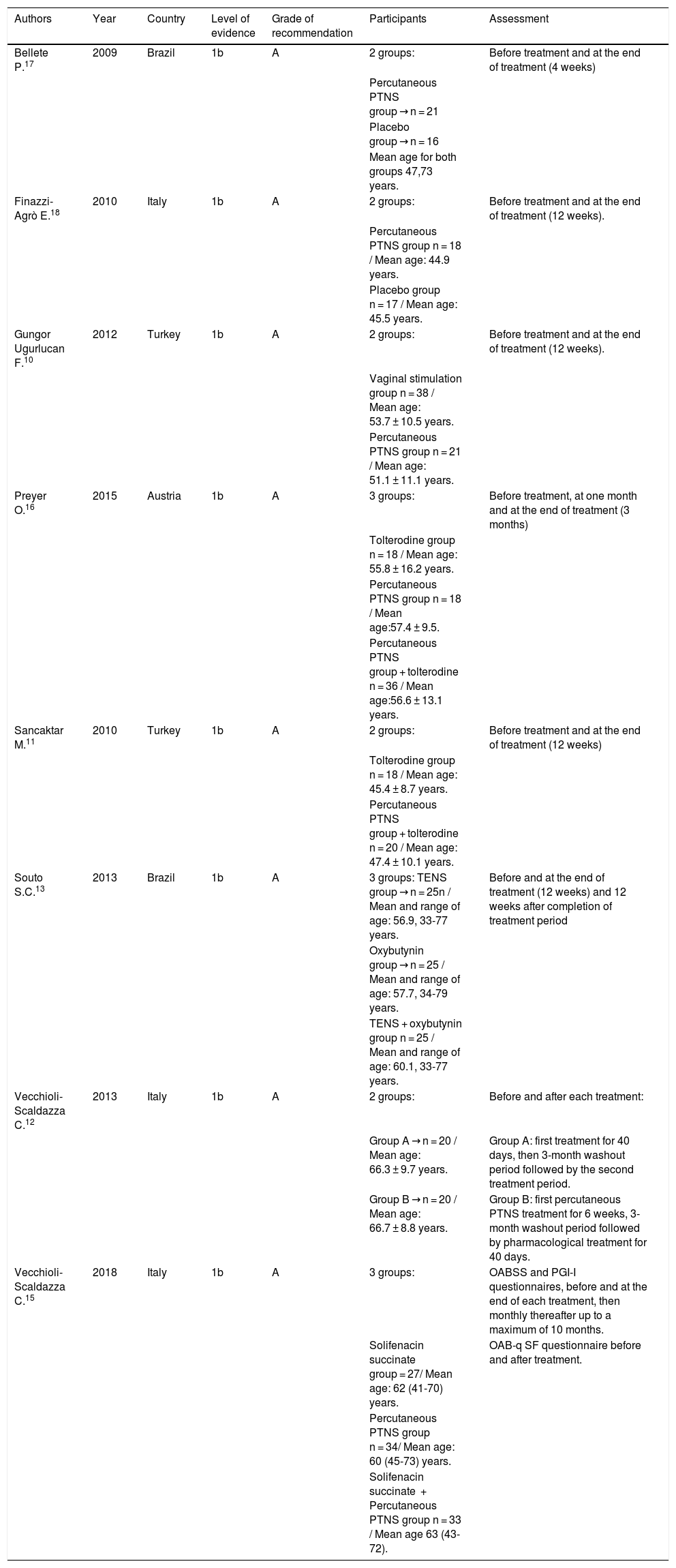Overactive bladder syndrome (OBS) is a urological disorder characterized by urinary urgency, increased frequency, nocturia, and may be associated with urge urinary incontinence (UI). Posterior tibial nerve peripheral neuromodulation (PTNS) is globally recognized within the treatment options available, although an optimal protocol has not been tested. The objective of this review is to collect the evidence available on the most widely used protocol of the PTNS technique in obtaining good results in the treatment for women with OBS.
Evidence acquisitionA systematic review of the scientific literature was carried out in PubMed, Embase, WoS and Scopus databases. A total of 222 results were obtained, with 58 duplicates, of which 8 studies met the established inclusion criteria, all of them randomized clinical trials.
Evidence synthesisThe included works show that the most widely used PTNS technique with beneficial results in women with OBS is the percutaneous route with a needle placed 5−6 cm proximal to the tibial malleolus, posterior to the edge of the tibia, with the following parameters: 1 weekly session of 30 min duration for 12 weeks, the use of pulse widths of 200 µs with frequency of 20 Hz.
ConclusionPTNS may have beneficial and safe short-term effects in women with OBS. Despite showing statistically significant improvements in clinical symptoms, further research is needed to obtain clear scientific evidence on the optimal protocol for treating women with OBS.
El síndrome de vejiga hiperactiva (VH) es una disfunción urológica caracterizada por urgencia miccional, aumento de la frecuencia de las micciones, nicturia y puede llevar asociado incontinencia urinaria de urgencia (IUU). Dentro de las técnicas de tratamiento, la neuromodulación periférica del nervio tibial posterior (NMTP) está reconocida internacionalmente como una de las vías de abordaje, aunque no se ha probado un protocolo óptimo. El objetivo de esta revisión es conocer la evidencia disponible sobre cuál es el protocolo de la técnica de NMTP más empleado en la obtención de buenos resultados en el tratamiento de VH en mujeres.
Adquisición de la evidenciaSe llevó a cabo una revisión sistemática de la literatura científica en las bases de datos Pubmed, Embase, WOS y Scopus. Se obtuvieron 222 resultados, con 58 duplicados, de los cuales 8 estudios cumplieron los criterios de inclusión establecidos, todos ellos ensayos clínicos aleatorizados.
Síntesis de la evidenciaLa técnica de NMTP más utilizada en los trabajos incluidos que muestran estos resultados beneficiosos en mujeres con VH es la percutánea con una aguja colocada 5−6 cm en posición proximal al maléolo tibial, por detrás del borde de la tibia y con los parámetros de 200µs de duración de impulso, 20 Hz de frecuencia, 30 minutos de tiempo por sesión y con una frecuencia que podría ser de 1 sesión por semana durante 12 semanas.
ConclusiónLa NMTP puede tener efectos beneficiosos y seguros a corto plazo en la VH en mujeres. A pesar de mostrar mejorías estadísticamente significativas en los síntomas clínicos, son necesarias más investigaciones para poder obtener evidencias científicas claras sobre el tipo de protocolo óptimo para el tratamiento de la VH en mujeres.









